|
|
|
 |
 |
|
|
|
|
|
|
|
|
| Tales of the Savikko Cotons Some of these stories have appeared in the Coton de Tulear News, a newsletter sent out quarterly by the CTCA with lots of current news and stories shared by Coton owners. All these stories on my website are written by my Coton families or my Cotons. (That's how smart my Cotons are!) Enjoy! |
|
Roki (The Precious Pooch) was born on July 7, 2000. We got him 10 weeks
later. He has not awaken us one night to whine or piddle. He loves to be
handled. Learns command and tricks easily. Smells good. Doesn't shed.
Doesn't yap. Our daughter who is allergic to anything with fur, hair, scales
or feathers doesn't have an allergy attack around him. Where ever we take
him, and that is almost everywhere, we (HE) gets oos and ahhs. Most
important, he brings a joy to our house that is indescribable. 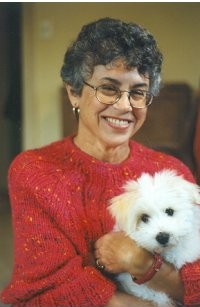 I give Coreen a great deal of credit for our terrific dog, Roki. He comes from good stock, was raised his first 10 weeks with many other puppies in a home environment and had good medical attention. Coreen was most kind to me for the year before we got Roki. She answered all my questions and kept me current as to when she expected a litter to fit my needs. 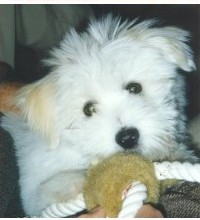 My daughter plans to get a dog in the future. It will be a Coton and it will be from Coreen. Written by Carol Porter PorterCL@aol.com |
|
I promise to love your socks off. I don't promise to tell you what I've done with them. I'll be there for you in the hard times. I promise to make you laugh so hard that you'll cry rapturous tears. Then I promise to lick them from your lashes (even if they aren't laugh-happy tears). When you touch my fur, I'll send tickles from your fingertips to your heart. You will be spoiled by my touch, only clouds and feathers could feel this good. My innocence will saturate your soul and burst out of you in the form of never-ending smiles and giggles. It will be very difficult for you to get angry with me - very good for humans with hypertension! There are many careers for which you may want to consider grooming me: Security System Operator Recycling Manager Landscape Maintenance Engineer specializing in selective tree pruning and lawn fertilization. Butterfly Chaser Massage Therapist Mental Health Counselor Artist - specializing in nose painting on glass Children's birthday party clown Nurse Written by Paula Glauber owned by Cara Mia of da Silva and Cassidy of Savikko 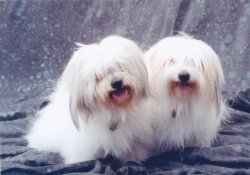 |
|
The Following article first appeared in The CTCA's Coton de Tulear News, Volume 10, Number 4, Summer 2000 issue: HOW MY DOG HANDLED A DEATH Some of you are aware of Bunny's close bonding with a human friend who was terminally ill. As the story has now come to a close, I'd like to share with you the surprising way my dog faced our friend's death: Bunny and I lived next door to Wini for the first four years of Bunny's life. About 70 years old, Wini (who had 2 cats and a pet tarantula) loved having Bunny around--she even appreciated Bunny's barking because it alerted her when someone was near--and Bunny began to regard Wini's condo as an extension of our home and felt welcome to go inside and upstairs to the living room whenever Wini's front door was ajar. A year or so after Wini was diagnosed with an inoperable cancer, her adult son moved in with her, and Bunny eventually accepted Marc into her Pack, as well. Whenever I'd suddenly "lose" my dog, I could be certain she was visiting next door. When I began to work out of an outside office 3-4 afternoons a week nearly two years ago, Wini volunteered to have Bunny stay with her, rather than Bunny being home alone. I was relieved--not only would she feed Bunny if I were going to be late at work, and let her outside to piddle/poop, but they would be good company for each other...and Wini would have all the joy of having a dog with only a small part of the responsibility. Bunny was blessing who kept Wini's spirits up, because Wini claimed she could never stay sad when Bunny was over. As Wini's health declined over the next year, Marc took more of the responsibility for letting Bunny outside, but it was obviously Wini to whom Bunny was devoted: The minute she entered their house, she'd always go directly to Wini and give her lots of kisses. If Wini was having a good day, Bunny'd spend as much time downstairs with Marc as upstairs with Wini, but when Wini was in pain, Bunny always stayed close to her, slept next to her, left her unchewed pig ear under Wini's blanket or pillow. Wini said Bunny could always tell when she was having an bad day, whether Wini was "off" physically or emotionally or both; you know how empathetic these dogs can be! After we moved to the Hovel last year, Bunny (who always hated cars and would never enter one voluntarily) was always eager to go if I said we were "going to see Wini." About 8 months ago, Wini became too ill to have Bunny stay with her, and I began to take Bunny with me to the office when it was very clear that my dog missed going to Wini's. In fact, Bunny was becoming downright depressed, started going potty in the house, and other behavior problems which some of you may remember I posted to the list. When I was finally able to take her over to visit Wini for 10 minutes one weekend day about two weeks later, Bunny was elated and her poor behavior lessened almost immediately, then stopped. For the last 3-4 months, we'd only get to visit Wini maybe once every two weeks, but Bunny would always run up the stairs to the couch next to Wini's chair so she could reach Wini's face to give her the kisses they both so enjoyed before I could ever make it there myself. Last Sunday, we visited Wini, who was still able to sit up in her chair in the living room and talk, and when Bunny saw Wini walk (to the bathroom, with my help), she danced all over wagging her tail, excited to see Wini up. I arranged with Marc that Bunny and I would come over the following Thursday night--this last Thursday--after work. The original plan was that we would stay with Wini so Marc, her caregiver, could have an evening out. But that Sunday was Wini's last day in the living room; on Monday, she took a turn for the worse and took to her bed, where she drifted in and out of consciousness and coherence--a combination of the cancer(s) and the morphine. Instead of Marc leaving, he and I--and Bunny, and one of Wini's cats--all stayed in Wini's bedroom. Wini was getting agitated, trying to get out of bed, losing coherence, and we comforted her and told her she didn't have to go anywhere, that she could just relax. We finally compromised: I sat with my arms around Wini as she sat on the side of the bed with her naked feet dangling. Sometimes Wini was lucid; more often than not, she wasn't. Bunny, on the carpet next to the bed, began to lick one of Wini's feet--and since Wini smiled a few times, I let Bunny continue. I was surprised that Bunny didn't try to kiss Wini's face--as she had Wini's standing permission to do so, and had always greeted her that way, but obviously Bunny realized that things had changed. Eventually, I began to think maybe Wini might have had enough of having her feet licked, so I told Bunny to stop. But when she ceased, Wini held out her foot to Bunny, an unspoken invitation to continue. We cared for Wini for 4-5 hours. When she finally went to sleep, Bunny and I left. Although Wini lived for three more days, she never woke again. Yesterday, Bunny and I went to visit Wini and bring some things to Marc. I sat with Wini while Marc showered and returned some phone calls. Bunny kept standing on her hind legs, trying to reach Wini's hand and falling just a few inches short, so I lifted Bunny up a little. She licked Wini's hand, and then was content. Last night, Marc called and said Wini had died less than a hour later. Bunny knew who was on the phone--she always knows who I'm talking to; I guess she can hear the voices through the phone--so when I hung up, I tried to tell Bunny, using terms she knew: "Wini is gone. No more Wini." It was the first time ever that I'd mentioned Wini's name that Bunny didn't wag her tail. Today, on our way to work, I stopped to give Marc a hug. Bunny ran upstairs before me, as usual, but this time, she didn't go to look for Wini. This time, she went straight to Marc. When Marc took a phone call, I took Bunny into Wini's bedroom--Marc had left the bed intact, Wini's imprint still on the pillows. I'd hoped that perhaps in some way, Bunny might understand that Wini was not coming back if she could smell and see. But Bunny already knew. She didn't go to the bed. She just looked at me for a moment before we left. Our dear friend Wini is gone, but we're very glad she's not in pain anymore. ------------------- Sherry and Bunny Sherry and Bunny writer@wordservices.com http://www.wordservices.com Sherry M. Gottlieb, a professional author of three books, usually presents a cleverly written piece about an amazing Coton de Tulear detective, Sam Spayed, in the CTCA's Coton de Tulear News. This important essay about the death of Sherry and Bunny of Savikko's dear friend, first appeared on the CTCA's CotonClub email list on Monday, July 17th, 2000. 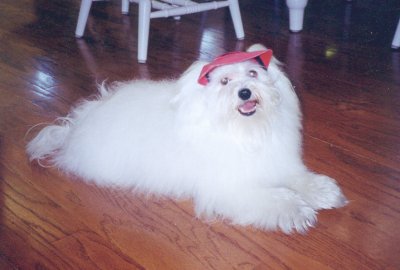 Bunny of Savikko |
|
Baileys' Goes Kayaking (As told to Wendie Marriott) The sun rose at 5:00 a.m. I awoke to robins chirping and stellar blue jays squabbling among themselves. At this time of year in Southeast Alaska, there is no waking to the crack of dawn . Dawn comes early and nightfall comes as late as 11:00 p.m. on some nights. On this particular day, Mom and Dad were moving early. They were especially chipper and I could sense the excitement in the air. Mom fed me an extra large portion of breakfast, my first clue that we were about to embark on an outdoor adventure, with the theory that I will need the extra energy. Could it be a hike? A spring ski trip? A camp out? Well now THIS was different. We headed for the water and a kayak was launched. Mom put me in a life jacket and, while she sat in the front hole of the boat snapping the canvas in around her, Dad picked me up and placed me on top of her skirt . He then launched the boat and off we were, riding the outgoing tide headed for the Tracy Arm Glaciers. 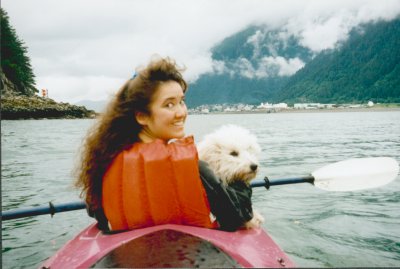 At first I found the rock and roll action of the kayak unnerving. Each time Mom and Dad dipped a paddle into the water, the boat would tip to that side. My well-manicured claws didn't grip too well in the fiberglass. I soon learned it was easier to sit in a relaxed fashion atop mom's skirt . Eventually I worked myself out of mom's grip and out a bit onto the bow of the boat. There were cords attached in a cris-cross fashion so as to hold a paddle or gear. For me, it provided an excellent opportunity to get a good grip out front, the male version of a mermaid with fly-away hair, as opposed to scales, if you will. And then the ocean came alive! The salmon were coming in to spawn, jumping out of the water all around the kayak. Some salmon can weigh in excess of 60 pounds and are a human and Coton delicacy. My four legged buddies love to come across dead, rotting salmon on the beach and roll around in them. But Mom calls me an Angel because I haven't played in dead fish - yet... In time the big fish joined us, only they were not really fish. They were 40 ton mammals; they were the humpback whales! These harmless beasts breach on the ocean surface, spouting a column of water 40 feet high as they open their breathing hole for air. 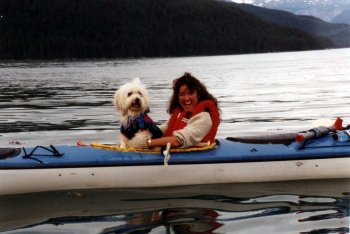 But I saw my tender young life flash before my eyes when I suddenly realized that we were caught in a bubblenet ! A bubblenet occurs when the whales feed on a school of herring. Swimming in a circular fashion below the fish, the whales blow bubbles to the surface, sort of corralling the feed. Then they lunge-feed to the surface, their tremendous jaws lined with baleen agape, gobbling up as many fish as possible. Mom and Dad had the good sense to slap the sides of the kayak as a warning and paddle to the fringe of the net . Just imagine, I could have come back in my second life as Moby Dick - The Coton! When the whales broke the surface in a tight curve and their huge tails could be seen, I knew they were sounding , diving to depths of hundreds of feet for up to 15 minutes. Eventually, a pod of killer whales or orca's swam by. These beautiful black and white mammals are a misnomer. Their name alone convey a feeling of danger when, in fact, they are completely harmless and have never been known to kill a fellow Coton. The males have much larger dorsal fins than the females and our friendly pod consisted of eight beauties. I think one was named Willie! When the whales were gone, the seals started quietly poking their heads out around us. These curious little creatures are grey, having bigger eyes than I do, and whiskers that go on forever. They started barking at me, so I conversed with them for awhile. I even fell head over paws in love with one of the little ladies! Mom and Dad paddled on towards the glacier. A cool breeze blew off the ice which was a relief, because Mom and Dads faces were burning from the sun's reflection off of the water. Some curious black oyster catchers circled the kayak, a mostly black bird with a brilliant long red bill, pink legs, and pink feet. I cocked my long ears at them, listening to songs of the males competing for the females attention. Icebergs were floating all over in the water and they got bigger the closer we got to the glacier. Mom and Dad picked their way slowly and carefully because only 1/3 of each 'berg floats above the water; 2/3 below the water line. These icecubes are known to roll and could easily capsize our puny little kayak. That would be a bad thing. As you can imagine, the water was very nearly freezing. Hundreds of seals were basking in the sun atop the icebergs. They seemed to have no problem slithering into the frigid waters as we paddled by. Suddenly an iceberg calved, sending a sort of tidal wave through the inlet. Mom and Dad pointed the kayak into the wave as it approached and Mom gripped me tightly. None-the-less, the water still came over the kayak, drenching us and sending a chill to the bone. Mom and Dad finally found a perfect little island in which to set camp. That night, when my belly was full of hot dogs and marshmallows, I settled in next to the campfire under the dancing northern lights of the Aurora Borealis. My peaceful dreams had all the makings of my wonderful Alaskan experiences - even the one real component missing from my otherwise perfect life - a pretty little Coton companion. Perhaps my next story should be titled "Baileys The Bachelor". (I could start a mail/male order business!?) Well, hopefully Mom gets my story down right. She has a tendency to exaggerate sometimes, you know. Gotta go chase a squirrel, now. I'll bark at you next time... Signed, Baileys of Savikko |
|
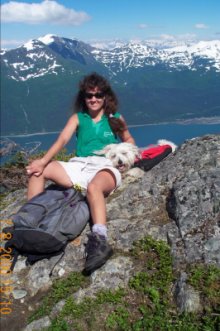
Greetings fellow cotton balls! Me again, Baileys, reporting in from the Great White North! This month I thought I'd tell you about my close encounters of the Alaskan kind. You see, one really interesting thing about living in Southeast Alaska is the way in which we are landlocked by glaciers. In fact, the only way in and out of Juneau is by plane or boat. Therefore, we are surrounded by mountains and a series of waterways. And since the mountains are there, they might as well be climbed. So climb them, we do. Mom and Dad's unusual preference for hiking mountains suits me just fine. After all, we Cotons are quite studly! But there are other rewards, too. Oh, sure, the air is incredibly fresh and clean with smells of spruce and hemlock. And yes, the 3600 foot views are sensational, overlooking the channel, town, glaciers, and 6000 passenger cruise ships. But for me, the most exciting thing about hiking these Alaskan mountains is my close encounters with dangerous wildlife! Take for example, the exalted eagle; the symbol of power and freedom, the icon for the United Nations, the chosen one for our American currency. Here in Southeastern Alaska, the eagle abounds. As a matter of fact, I see more eagles on any given day than I do creepy crawly insects. But alas, the eagle is a ferocious meat eater, far outweighing most of us Cotons. And Mr. Eagle, the Beautiful, would like nothing more than to swoop down on yours truly, sinking his talons into my poofy coat, and having me for a mid-day snack. Among the dog world here, rumor has it that many years ago an unsuspecting couple was touring Alaska in their motor home. At a rest stop, they let their Chiwawa (gag me with a dog biscuit) out to pee. Mr. Eagle snatched the dog up just as quickly as you can lift a leg, thereby putting a quick end to that yappers life (and the mans anguish, so the story goes!) Another foe to dog-kind in the land of the midnight sun is the porcupine. This slow moving, waddling creature is covered from head to toe with quills. There are all kinds of horror stories from my four legged friends who have encountered this seemingly harmless creature. The first time I saw a porcupine was outside our house. Dad had gone to put the garbage out and this cute little creature came innocently waddling into the garage. I went out to introduce myself, maybe engage the little guy into a game of tag or something. All of a sudden Mom was screaming hysterically from the door. The urgency in her voice was the only thing that made me stop and retreat. It's a good thing, too, because on a subsequent hike, my German Shepard friend, Zach, sniffed out a porky and got whacked in the face by the little guys tail. Zach came whining back to his mother and all the humans had to conduct "surgery" right there on the trail, removing the barbed quills from his nose, tongue, and face. Now that's what I call a Zach Attack! It turns out that porcupines come out in force on full moons and local veterinarians line their pocket books with big money. 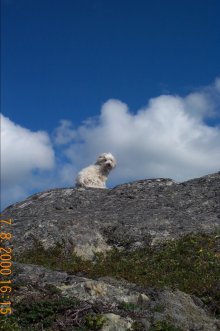 And who could talk about Alaskan wildlife without mention of the most revered of the animal kingdom - the one, the only, THE BEAR!?! In actuality, the bear is not a common sight here because of their allusive nature. Their extremely keen sense of smell and sound afford them the opportunity to clear out of our way long before we hike by. But I remember one hike in particular where I saw seven bear in one day! Yes seven! Count them on your paws; one, two, three, four, five, six, seven! It was an unusually long 11 mile hike in which we ascended Mt. Juneau, a 3600 foot mountain named after Joe Juneau who discovered gold in the mountain back in the 1800s. From there we hiked along a five mile ridge line before dropping down into a series of basins and out another trail, thereby completing a loop. It was September and the bears were fattening up on lowbush blueberries before their winter hibernation. Because we were hiking the ridge well above tree line, the view afforded us an opportunity to look down on either side of us so that we could see the bears but they were (thankfully) unaware of us. That day we saw a sow and one cub, a sow and two cubs, and than two cubs traveling together. Now let me tell you for a moment about what it's like to see a bear. It's humbling, plain and simple. These animals are at the top of the food chain. If you ever stumbled accidently face to face with Mr. Bear on the trail, you could just kiss your sweet pampered Coton butt goodbye. And don't expect Mom and Dad to save you either because while you might be the hor d'eurve, Mom and Dad would be the main course. But from our vantage point some quarter of a mile away in each case and the humans armed with rifles and pepper spray, the bears were still magnificent animals to watch. Indeed, my close encounters of the Alaskan kind never cease to amaze me. It's no wonder why I love to hike so much in this Coton Northern Exposure. Gotta run now, there's another mountain to climb. I'll bark at you next time... Signed, Baileys of Savikko |
|
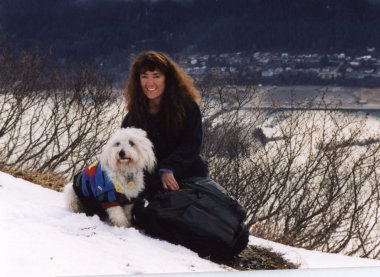 A century has passed and the time has come to retrace the Miner's footsteps. Mom and Dad decided that I, as Alaska's most famous Coton, was the dog for the job. But I am jumping ahead of myself, so let me back up and explain a little human history. Some 100 years ago, GOLD was discovered in Alaska and the Yukon. News hit "the south" about fistfuls of golden nuggets that were literally dripping from the mountainsides and that was all it took to initiate the gold rush of 1898. Thousands of men and women stampeded to Alaska in the search to strike it rich, forever changing the face of what was to become the 49th state. The 33-mile Chilkoot Trail begins in Dyea out of Skagway, Alaska, continues over a mountain range, and drops into the Yukon, Canada. Today it is still littered with tin cans, horse bones, abandoned churches, cable, trusses, even one-ton pot-bellied stoves, a testament to the hardships of man and beast and now considered artifacts not to be removed from this historic trail. For a Coton stud of the 20th Century, however, sniffing out the route was pure pleasure and adventure. Mom strapped a modern-day pack purchased from R.E.I. onto my back and loaded me up with my own gear, some food, leash, and treats. We ventured out into the wilderness on our 3¸-day expedition. Other hikers were pretty enthralled by the site of me. Most humanoids choose not to bring their dogs on this grueling hike and many have most certainly never seen a Coton before. I always love the dialog between them. Without fail, it always goes like this: "What kind of dog is that?" "A Coton de Tulear." "A what?" Blah blah blah. Get a life people! Ironically, the comments I elicit from people are not really about my looks - it's the pack, if you can believe that! "Oh, look at the little dog carrying his own pack!" they inevitably say. But I must admit, I am no foo-foo Coton, and when I go hiking I am not at my best looks-wise. Sticks stick to me, moss and lichen embed into my mustache, the earth adheres to my underside, and a walk in the woods usually brings about some 50-plus mats on my 29-pound body. So we hike about 12 miles the first day, gaining some 1000 feet in elevation, finally settling down at Sheep Camp on the American side of the border. Mom and Dad hung their food, including my pack, from poles so as not to attract bears, the Alaskan animals at the top of the food chain. A tent was pitched and the camp stove was used to cook a hot meal that evening. Mom and Dad thought they were "roughing it" by adding water to boil up freeze-dried camp food. But they shared some with me, which was gourmet compared to the hard, dry dog food that I normally get. A National Park Ranger walked through the camp and invited the three of us to a short lecture up in the Forest Service cabin that night. One of the many things she told us was to be careful of the poisonous berries. Since I like to eat berries off the bushes, I perked up at this discussion. "A good rule of thumb, or paw as the case may be," she said while glancing my direction, "is that red berries that hang in clumps like devils club and mountain ash are usually poisonous. On the other hand, or paw," she continued, "berries that hang in a singular fashion like salmon berries, watermelon berries, and strawberries, are usually edible." The Ranger grinned in spite of herself, obviously pleased with her clever play on words. Day two was the most interesting and grueling part of my adventure. It was relatively long, some 11 miles, and over 3000 feet in elevation was gained. It was also the most well known part of the trail. The famous "golden staircase" is the steep portion prior to reaching the summit, which delineates the U.S. and Canadian border. In the summer it is simply a mountain of huge boulders, lined with poles by the Park Rangers to mark the easiest route by which to navigate. But the image that comes to mind for most people when they think of the Chilkoot Trail is a miner's photo of a snow-capped mountain dotted by hundreds of black figures. These men are in a line, gripping a rope, accending the snow carved stairs, stooped over with the strain of one hundred pound packs strapped to their backs. During the gold rush, the Canadian Mounties refused passage to anyone who could not produce one ton of provisions to last them through the winter. Most men made over twenty trips and upwards of a month to haul their goods to the peak. Many collapsed with fatigue in the dead of winter. Many discarded pounds of extra weight, littering the mountain with what was to become outdoor artifacts a century later. Pack horses died by the hundreds at Dead Horse Gulch. And sobering make shift cemeteries could be found scattered alongside the trail. I, on the other hand, took all of about three hours to break Sheep Camp and reach the peak. I sat at the peak to admire the view and reflect upon the history of this famous trail. I knew there was still another day-and-a-half before reaching Lake Bennett where the trail terminated. I thought about how most of the people did not even find gold, broken and defeated by an illusion that was not to be. Retracing the Miners footsteps of a century gone by was humbling in many ways. Necessity and greed drove the men and women of yesteryear. Mom, dad and I were here for the pure pleasure of it all. I decided to salute the miners of the past century in the most appropriate fashion for a Coton. I marched over to the largest boulder at the peak, a black and gray granite monstrosity. I sniffed it carefully and then stood on three legs, lifting the rear, right leg high into the air. With that, I thereby staked my own claim in a unique de Tulear sort of way. It seemed as though I could hear the approval of the miners whispering on the wind. I knew they would be proud. Well, gotta run. I'll bark at you later. Signed, Baileys of Savikko |
|
By Baileys of Savikko (As told to mom, Wendie Marriott) 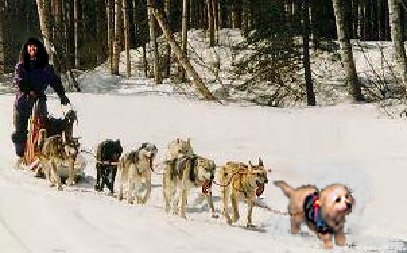 It was the crispest of mornings, twenty degrees below zero, two hours yet before sunrise, and not a breath of wind. The excitement was mounting within me as it was with the other dogs, the mushers, and the two thousand spectators who came to watch the start of the 1998 Iditarod Sled Dog Race. I was in the heart of Anchorage, the largest city in Alaska, for one of the most challenging and unusual endurance races in the world. The Iditarod Sled Dog Race follows the route of the famous effort of 1925, to carry the life saving diphtheria serum to children 1049 miles away in Nome. The object of the race is for one musher, a sled filled with supplies, and a team of 5-16 dogs to cross the finish line; a feat that can take over fourteen days. The first team to reach Nome with the mandatory supplies wins - currently up to $51,000. My team caused quite the media attention as we maneuvered our way to the starting line. We were the 38th team to leave from two minute staggered starts, but we were most unusual. For starters, we were rookies. Neither mom nor I had mushed in the Iditarod before. Mom was only one of three women in a pool of 65 total racers this year. But our teams' most unique quality was little 'ol me. No one had ever even heard of a Coton before, let alone seen one. Although I was quite handsome in my ski jacket and booties, dogs from other teams "snubbed" me, and called me a "sissy". Several television stations were there as well. Mom's face was crammed with microphones and she patiently explained time and time again that her "lead dog was a very rare breed from Madagascar called a Coton de Tulear - which is French for cotton. Tulear is the port city from Madagascar where the breed comes from. His name is Baileys after my favorite drink, Baileys and coffee. He has to wear a jacket because he's got hair, but no fur. You see, he can get very cold in this weather. What do I think our chances are? Well, you might be surprised. Baileys is quite strong and intelligent, you know?" And on, and on, and on. Most sled dogs are Alaskan Huskies or dogs of a Siberian Husky mix. Our team was no exception, except of course, for me. The headlines at home read "COTON IN THE IDITAROD - WHAT NEXT?" But no matter. I smiled politely at a cameraman, lifted my leg on his tripod, and barked orders to my fellow teammates. Then I sprang to life when Mom yelled, "Hike", the command to go. More than a few jaws dropped as we darted out of the starting line in perfect order lead by a white puff of cotton in a ski jacket! The crowd cheered for us as we passed, yelling words of encouragement, and energizing our spirits! But then the work began. Within a day, the climate and terrain changed significantly. Most times we were alone in the wilderness, overtaking only one team, and being passed by three others. Luckily our team was healthy and strong, and I was very responsive to mom's commands. She would yell "gee" when she wanted me to go right; "haw" for turn left. "Come gee" or "come haw" meant to bring the team and sled completely around. My position of lead dog is considered the most important job. I am expected to stay out front, keep the lines tight, keep my teammates moving, and be respected as their fearless leader. My responsibility is to stay on the trail. During blizzards I may become temporarily blind by the snow. It is then that my sense of smell and touch take over. Mom and my teammates rely upon these skills of mine. My buddies have important jobs, too. Mocha and Latte are the swing dogs, whose responsibility is to keep the dogs on the trail instead of jumping off of it during the turns. The team dogs are the big guys. They have only one chore and that is to pull. In the rear are the two biggest dudes, the wheel dogs, Rocky and Arnold. Their main function, located directly in front of the sled, is to steer and keep the runners on the trail. As the sun set and the temperatures dropped, Mom could tell we were getting hungry and tired. We had already passed through Knik when she pulled over to cook us up some food and give us a chance to rest. While boiling herself some hot water, she snacked on some trail mix and put on her headlamp. Five other teams stopped near us, but very few of we dogs spoke to one another. We understood that sleep would be precious for the next couple of weeks and it was necessary to take advantage of it whenever we could. After a forty-five minute rest, we were off again, this time towards Skwentna. Before long, days merged into nights and wilderness turned into vast expanses of ice. Checkpoints consisted of Alaskan native villages with names such as Nikolai, Takotna, Shageluk, Kaltag, Shaktoolik, and Koyuk. At each stop veterinarians would check my buddies and I out. Officials would make certain that mom had the mandatory supplies: a cold weather sleeping bag, a hand ax, a pair of showshoes, one day's food for each dog (at least two pounds per dog), a day's food for the driver, eight booties for each dog; and a packet of envelopes postmarked in Anchorage. These letters would later be postmarked in Nome and sold to raise money for the race. Mom had flown in supplies the previous week to various checkpoints. She would take these opportunities to rest us while she restocked the sled. Nights were the toughest times for me, especially when Mom would choose to camp out on the trail for a few hours. Knowing I was not of a breed that could withstand the subzero temperatures, she would let me snuggle in the sleeping bag with her while my buddies huddled together out in front of the sled. But they were pretty cool about it and did not consider me a spoiled brat. They got too hot on the sled anyway and relied upon my superior intelligence to get them through this race. We knew that we were a team whose survival literally depended upon one another. By this time, the race was beginning to take its toll. Out of Ophir, our team had come upon a stubborn moose who refused to yield to us. Against my teammates prodding, I had the good sense to stop and stare the guy down. My buddies barked which only seemed to infuriate the eight-foot moose more. At one point Mom thought he was going to charge us. She finally pulled out her pistol and fired into the air. That seemed to scare him off and we were able to proceed after a good hour's delay. Another time we got tangled around a tree when Mocha and Latte weren't paying attention. The sled tipped onto its side and Mom had to redo the gangline so the team could pull it back into an upright position. She mumbled four letter words when other teams passed us by with smirks on their faces. Mom's strategy was slightly different than the other teams. She chose to stop for breaks more frequently than others, but for much shorter periods. A team would usually pass while we rested, but we would gain on at least two before the next stop. By the fifth day we had moved into 12th place! Being of the sentimental sort, Mom decided that it would be appropriate to take our mandatory 24-hour stopover in Iditarod, the approximate half-way point of the race, and the town which the race was named. This is where strategy came into play. Most mushers had chosen to take their 24-hour stop much earlier, giving them plenty of time to jockey for a frontrunner place later in the race. But this deprived dogs and mushers of much needed rest when they needed it most for the race to the finish. At checkpoints dogs were treated well, but little attention was given to mushers. Only mushers are allowed to tend to their dogs, and this must be done before they can do anything for themselves. As a result, mushers tend to get a bit coo-coo, hallucinate, and make poor judgements late in the race when a good head is necessary. In Iditarod, mom was treated to a stew dinner, a cabin to sleep in, and a hot shower in the morning. I was the only dog in the entire race that was allowed to sleep in the cabin, too! The next morning I checked on my buddies. Mocha had cut a pad on the river ice, but a vet had tended to it and it was healing nicely. The 24-hour stop in Iditarod did wonders for us all. The next day we were well rested, fed and refreshed. We were ready to start well ahead of schedule and by 3:24 p.m., we were released out of the chute. We had our work cut out for us though, because by day seven we had slipped to 15th place. A snowstorm blew in out of Grayling from the south. Although it made navigating extremely difficult, the push from behind actually gave us a new surge of energy. Then everything started going in our favor. News at the checkpoints revealed that the first place team had to drop its lead dog and that another musher had succumbed to the flu. One poor musher had broken a runner on his sled, one of the worst things that could happen to a racer. It was day ten. We were now in 4th place! Mom's breaks became shorter and less frequent, but her words of encouragement flowed a-plenty! "Gee, Baileys," "Good Boy," she would yell from the back of the sled. Although she wasn't very strong, she was agile and was able to foresee obstacles before we came upon them. We passed yet another musher and left three minutes earlier than the third place team out of Golovin. Mom said it was a good thing that there were no nice smelling ladies on the frontrunning teams, or I would never have had the desire to push to the front. But the ladies on those teams didn't interest me, so I peed on their sleds and passed them instead. We were in first place and the rush to the finish was on! The next team was only a few minutes behind us, but we were pulling ahead. Suddenly a roar went up from the crowd just as the sun broke the horizon on the thirteenth day and we came into sight - the little team that could! People went wild when they realized that it was the little Coton in the ski jacket with a female musher! Mom got off the sled and came around to the front so that her and I could cross the finish line together! I was the happiest Coton, or dog for that matter, in the whole world! I gave the photographers my finest grin when they walked Mom and I to the winning platform, put a wreath around my neck, and snapped photo after photo. The news went out around the world: "COTON WINS THE IDITAROD - AN AMAZING DOG!" "Baileys! Baileys! Wake up! You're having a dream!" Huh - what? I opened my eyes to find Mom gently shaking me. I was on Mom and Dads' waterbed at home. Aw, shucks. Right when they were about to award Mom the $51,000 check, too. Oh, well, her loss. She shouldn't have woken me. I closed my eyes and went back to sleep. A stud can dream, fellow Cotons, a stud can dream! |
 |
[ Home News About Find Us Links Contact Galleries Stories ]